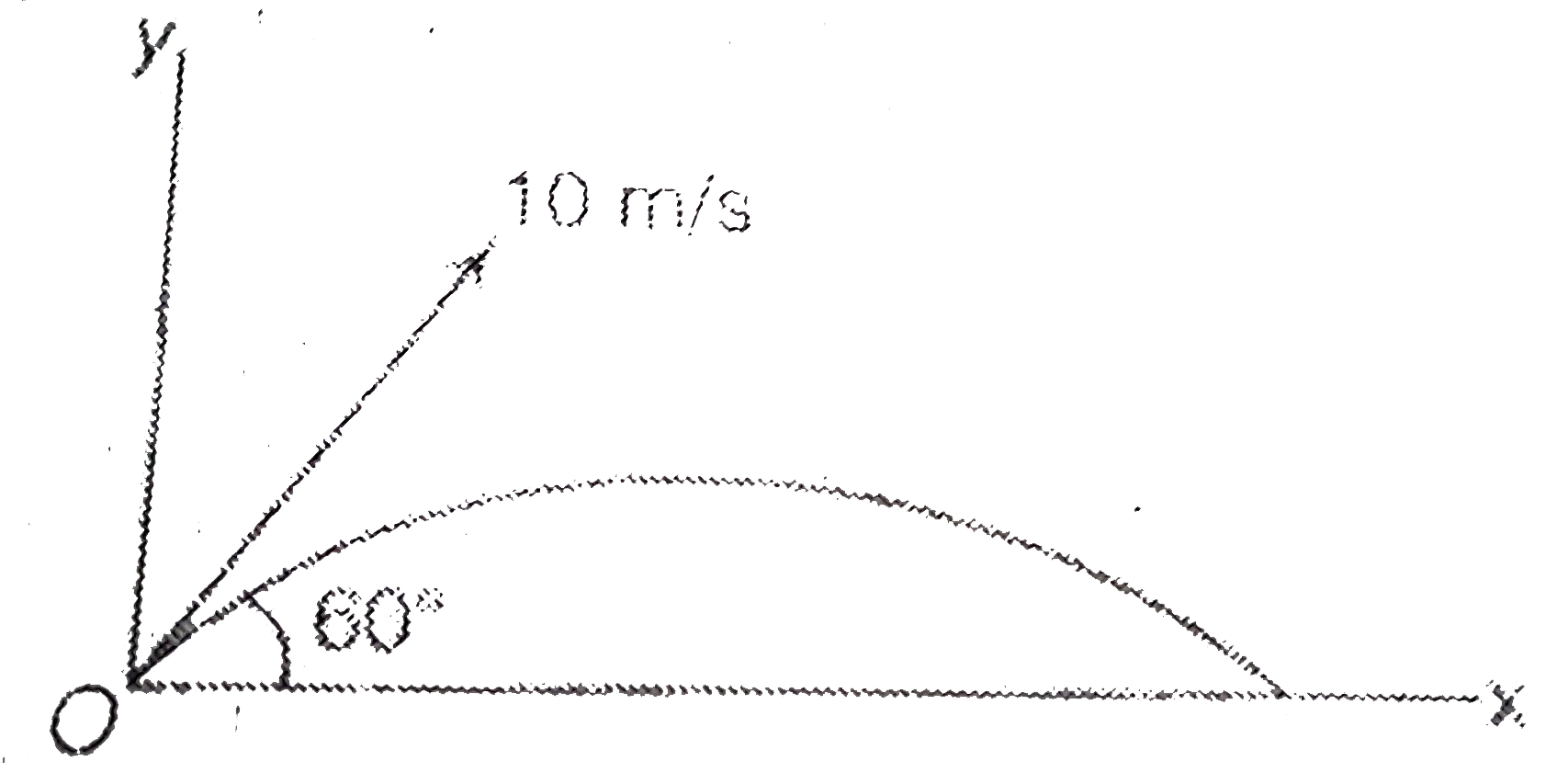A particle is projected at an angle of 60∘ above the horizontal with a speed of 10m/s. After some time the direction of its velocity makes an angle of 30∘ above the horizontal. The speed of the particle at this instant is s
5√3m/s
5√3m/s
5m/s
10√3m/s
The correct Answer is:D
To solve the problem step by step, we will analyze the motion of the particle projected at an angle of 60∘ with an initial speed of 10m/s and find the speed when the direction of its velocity makes an angle of 30∘ above the horizontal.
Step 1: Determine the initial velocity components
The initial velocity u can be broken down into its horizontal and vertical components using trigonometric functions.
- The horizontal component ux is given by:
ux=u⋅cos(60∘)=10⋅12=5m/s
- The vertical component uy is given by:
uy=u⋅sin(60∘)=10⋅√32=5√3m/s
Step 2: Analyze the horizontal motion
The horizontal velocity vx remains constant throughout the projectile motion since there is no horizontal acceleration (assuming no air resistance):
vx=ux=5m/s
Step 3: Analyze the vertical motion
The vertical component of the velocity vy changes due to the acceleration due to gravity g. The vertical velocity at any time t can be expressed as:
vy=uy−g⋅t
Step 4: Use the angle of the velocity at the instant
At the instant when the direction of the velocity makes an angle of 30∘ above the horizontal, we can relate the horizontal and vertical components of the velocity using the tangent function:
tan(30∘)=vyvx
From trigonometric values, we know that:
tan(30∘)=1√3
Thus, we can write:
vy5=1√3⟹vy=5√3m/s
Step 5: Calculate the speed of the particle
The total speed s of the particle can be calculated using the Pythagorean theorem:
s=√v2x+v2y
Substituting the values we have:
s=
⎷(5)2+(5√3)2
Calculating further:
s=√25+253=√25+8.33=√33.33=5√33m/s
Final Answer
Thus, the speed of the particle at the instant when its velocity makes an angle of 30∘ above the horizontal is:
s=10√3m/s
The initial velocity u can be broken down into its horizontal and vertical components using trigonometric functions.
ux=u⋅cos(60∘)=10⋅12=5m/s
uy=u⋅sin(60∘)=10⋅√32=5√3m/s
The horizontal velocity vx remains constant throughout the projectile motion since there is no horizontal acceleration (assuming no air resistance):
vx=ux=5m/s
The vertical component of the velocity vy changes due to the acceleration due to gravity g. The vertical velocity at any time t can be expressed as:
vy=uy−g⋅t
At the instant when the direction of the velocity makes an angle of 30∘ above the horizontal, we can relate the horizontal and vertical components of the velocity using the tangent function:
tan(30∘)=vyvx
From trigonometric values, we know that:
tan(30∘)=1√3
Thus, we can write:
vy5=1√3⟹vy=5√3m/s
The total speed s of the particle can be calculated using the Pythagorean theorem:
s=√v2x+v2y
Substituting the values we have:
s=
⎷(5)2+(5√3)2
Calculating further:
s=√25+253=√25+8.33=√33.33=5√33m/s
Thus, the speed of the particle at the instant when its velocity makes an angle of 30∘ above the horizontal is:
s=10√3m/s
Topper's Solved these Questions
- KINEMATICSBook:DC PANDEYChapter:KINEMATICSExercise:MCQ_TYPE
Explore 23 Videos
- KINEMATICSBook:DC PANDEYChapter:KINEMATICSExercise:COMPREHENSION_TYPE
Explore 13 Videos
- KINEMATICSBook:DC PANDEYChapter:KINEMATICSExercise:Subjective Questions
Explore 24 Videos
- GRAVITATIONBook:DC PANDEYChapter:GRAVITATIONExercise:(C) Chapter Exercises
Explore 45 Videos
- KINEMATICS 1Book:DC PANDEYChapter:KINEMATICS 1Exercise:INTEGER_TYPE
Explore 15 Videos
Similar Questions
A particle is projected at an angle of60∘ above the horizontal with a speed of 10m/s .When the projectile reaches highest point, change in velocity is
View SolutionA particle is projected from the ground at an angle of 60∘ with the horizontal with a speed by 20 m/s. The radius of curvature of the path of the particle, when its velocity makes an angle of 30∘ with horizontal is 809.√xm Find x .
View Solution
Knowledge Check
A particle is projected at an angle θ=30∘ with the horizontal, with a velocity of 10ms−1. Then
AAfter 2 s, the velocity of particle makes an angle of 60∘ with initial velocity vector.BAfter 1 s, the velocity of particles makes an angle of 60∘ with initial velocity vector.CThe magnitude of velocity of particle after 1 s is 10ms−1.DThe magnitude of velocity of particle after 1 s is 5ms−1.A particle is projected at an angle 60∘ with the horizontal with a speed 10m/s. Then, latus rectum is (Take g=10m/s2)
 A5mB15mC10mD0
A5mB15mC10mD0A projectile is projected at 10ms−1 by making an angle 60∘ to the horizontal. After sometime, its velocity makes an angle of 30∘ to the horzontal . Its speed at this instant is:
A10√3B10√3C5√3D5√3
A ball is projected at an angle of 30∘ above with the horizontal from the top of a tower and strikes the ground in 5s at an angle of 45∘ with the horizontal. Find the height of the tower and the speed with which it was projected.
View SolutionA particle is projected with velocity 50 m/s at an angle 60∘ with the horizontal from the ground. The time after which its velocity will make an angle 45∘ with the horizontal is
View SolutionA ball is projected at an angle 60∘ with the horizontal with speed 30 m/s. What will be the speed of the ball when it makes an angle 45∘ with the horizontal ?
View SolutionA particle is projected from the ground at an angle of 60∘ with horizontal at speed u=20m/s. The radius of curvature of the path of the particle, when its velocity. makes an angle of 30∘ with horizontal is :
(g=10m/s2
View SolutionA projectile is fired with a velocity u at an angle θ with the ground. At some instant during motin, its velocity makes an angle α with the horizontal direction. The speed of the particle at this time will be
View Solution

